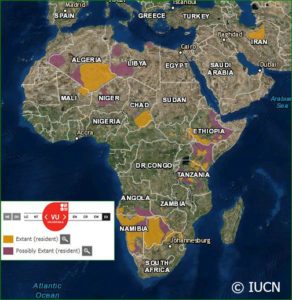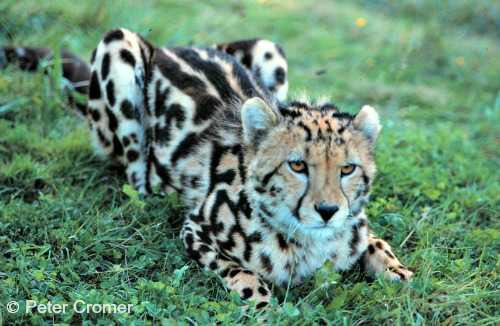
- HB Length:113-140 cm (44-55″)
- Tail Length:60-84 cm (24-33″)
- Height: 75-85 cm (29-33″)
- Weight: 21-65 kg (46-143 lbs)
- Pop. Trend: Decreasing
The Cheetah Acinonyx jubatus, with its strange mixture of dog like and cat like features, is one of the world’s most popular cats. Famous for being the fastest land animal, their speed has been estimated at about 95 km per hour for a brief period. This kind of speed is only possible over open ground, thus they are limited in their range.
The fur has a background colour of light golden yellow, covered with small, round, black spots on the cheeks, forehead, crown, neck, and limbs. The tail, spotted above and pale below, has three to six black rings near the end, and a white tip. One of their most distinctive features is the black line, or tear stripe, running from the eye to the corner of the mouth. The ears are black, but tawny at the base and edges. They have a mane-like black stripe running the length of their back. In some animals this stripe is highly pronounced, and the body spots flow together to produce stripes and blotches. Animals with this coat pattern are called King Cheetahs.
Distribution

Once ranging over most of Africa’s open areas and the grasslands of India, Pakistan, Russia, Iran and the Middle East, the majority of these cats are now found in east and southern Africa. Cheetahs have lost 76% of their historic range in Africa.
Where large-scale ungulate migration patterns are still intact, wide-ranging solitary females – average home range of 800 km2 – pass through small temporary territories of around 50 km2, held by small groups of males. In areas where prey is non-migratory, males and females have overlapping home ranges that are similar in size.
On the Serengeti plains, densities range from 0.8/100 km2 to 1.0/100 km2, but they can congregate seasonally, bringing densities up to 40/100 km2.
In 1993, a remnant population was found in Egypt. These northern cats are smaller and stockier than their southern cousins. They also have unusually large ears, and a pronounced, square muzzle. The coat colour is lighter, and the black markings muted.
These cats are found in the Sahara Desert and savannahs of north and west Africa. Their population is small and fragmented, and researchers estimate they number less than 250 animals.
Ecology
The Cheetah shows many adaptations for fast running. Long legs and a flexible spine permit a long stride length for extra speed, exposed claws act like running spikes, and large nostrils assist breathing and cooling off during and after a sprint. Their canines are relatively small, leaving a larger nasal aperture between the roots for more air intake following the chase. They have a relatively larger heart, lungs, adrenal glands and air passageways as well. Their feet are equipped with hard pads that have ridges, possibly acting like anti-skid treads. The long tail is essential as a counterbalance for turning.
Cheetahs rely on stalking to within about 30 metres of their prey, and then a short sprint of 20 – 60 seconds. When they catch up to a fleeing animal, they attempt to knock it off balance with a swipe of a front paw. Actually, they are trying to hook it with the enlarged front dew claw which is located up off the ground on the inside of the front leg. Larger hoofed animals are taken by cooperating groups of males, usually litter-mates. Although they will drink if it is available, Cheetahs apparently do not require fresh water, obtaining enough moisture from their prey.
These cats hunt more often in the daytime than the other carnivores in their range, for a number of reasons. First is the need to see the terrain during high speed chases; second, they can eat their prey with less chance of disturbance from nocturnal carnivores. In the Saharan mountains, where larger predators no longer survive, the Cheetahs hunt during the cooler night hours.
Females are solitary and appear not to be territorial. They tend to follow the prey animals and will overlap with other females in the same area. Related young males form groups of two to four and occupy small territories. These coalitions defend their territories against other males for all or most of the year. Coalition males appear to live longer, healthier lives and so may have more years for breeding than solitary males.
Reproduction
Unlike most cats, Cheetahs do not have a regular breeding season. Cubs may be born in any month. The average litter size is three, but the range is from one to eight. The gestation period is 90 – 98 days, with the birth size 150 – 300 grams. Their eyes open around four to 11 days of age. The cubs are kept hidden in dense grass or under bushes until five or six weeks of age. The blue grey ruff or mane running down their back probably aids in camouflaging them during this time. Weaning occurs around three months. Males do not take part in the rearing of the cubs, and are actually predators on the young. Many other carnivores will kill young Cheetahs, including hyenas, Lions Panthera leo, Leopards Panthera pardus, and eagles. Less than one third of a litter is likely to survive to adulthood. Record longevity has been recorded at 17 years
Conservation
Ten to twelve thousand years ago, the Cheetah suffered a massive die-off. Prior to this, there had been many different species, but only a small number of the modern species survived. It is from this remnant population that all Cheetahs alive today have descended. As a species, they are genetically identical, with only 2% genetic variation compared with 10% or more in other cats. A skin graft from any Cheetah will grow normally on any other Cheetah in the world, while a graft from any other cat will wither and die. The potential for a virus to wipe out large numbers is high because of the lack of variation in disease resistance.
Habitat loss and fragmentation, conflict with people and depletion of their prey species are the most serious threats to the survival of the Cheetah in Africa. Competition with larger carnivores also leads to Cheetahs achieving higher densities outside of protected areas.
The oil-rich Middle Eastern countries are also depleting populations with their demand for Cheetahs as status pets. Many of the cats captured for the pet trade die on route, and killing of the breeding female to take the cubs results in a huge loss to the already endangered gene pool.
Compare these cats with the critically endangered Asiatic Cheetah.
Range map courtesy IUCN Red List 2008
Updated 2016

diana dayn
One of the best and my favorite blog ever.
sheneneh
this is outrageous. why keep them on leashes and in captivity they shouldn’t do this at all.